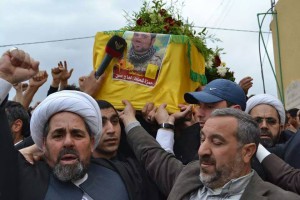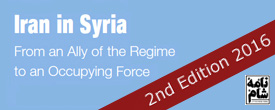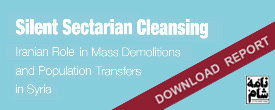 Three Lebanese journalists working for Hezbollah Lerbanon’s Al-Manar TV were killed and two others injured on 7 April 2014 after their car came under gunfire attack in the historic town of Maaloula in Syria.
Three Lebanese journalists working for Hezbollah Lerbanon’s Al-Manar TV were killed and two others injured on 7 April 2014 after their car came under gunfire attack in the historic town of Maaloula in Syria.
Reporter Hamza Haj Hassan, cameraman Mohammad Mantash and technician Halim Allaw were among a convoy of ‘friendly’ media workers, including some from the Iranian state-run Arabic-speaking channel Al-Alam TV. They were accompanying Syrian regime and Hezbollah forces as these took over Maaloula from opposition forces, along with two other towns in the Qalamon region near the Lebanese border. Maaloula had been under the control of rebels since December 2013. They had been driven out of it twice before.
Hezbollah, Iranian and Syrian officials were quick to condemn the “cowardly act” and blame “takfiri terrorists” for it. But important questions remain unanswered:
1. According to al-Manar itself, the attack came hours after the Syrian regime and Hezbollah forces recaptured Maaloula and drove the opposition forces out. It was reportedly “under their full control”. So where did these opposition forces that opened fire on the media convoy come from? Why had they not been driven out too?
Haj Hassan’s last Twitter message sounded relaxed and confident. [1] He even named the hotel where he and his colleagues were going to stay that day (al-Safir hotel). Would any sensible journalist publicly reveal his location if he was not confident that he would be safe there?
2. These and other facts have given rise to speculations among Syrian and Lebanese commentators that the Hezbollah and Iranian media convoy may have been fired at by angry Syrian soldiers as tensions between the Syrian regime on the one hand and Hezbollah and Sepah Pasdaran leaderships on the other reached unprecedented levels in recent days.
Last week the Syrian president’s political and media advisor, Buthayna Shaaban, slagged off “friendly TV channels” that “have recently been broadcasting interviews and reports that kind of give the impression that the Syrian state would not have held up if it was not for so-and-so state and such-and-such party.” [2] The “friendly channels” referred in particular to Hezbollah’s al-Manar TV and the Iranian-funded al-Mayadeen. In reaction, al-Mayadeen decided to significantly reduce its coverage of the war in Syria (or its propaganda, rather); al-Manar managers and Hazbollah commanders were reportedly “very pissed off”, even though they were later reassured that “nothing will change” as Shaaban retracted her statement and the Syrian minister of information tried to water down the measures his ministry had taken (requiring these channels to apply for prior permission before covering battles). [3]
Syrian soldiers and Hezbollah fighters were recently heard exchanging insults on radios and blaming one another for heavy losses. [4] There have even been roumers of tensions at the highest levels between the Syrian and Iranian regimes following statements by Iranian officials that it is Iran that has kept Bashar al-Assad in power. [5]
So could it be some angry or insulted Syrian soldiers who opened fire on the Hezbollah and Iranian media convoy? Or could it have been orders from higher levels in the Syrian regime to send a message about who’s in charge here?
3. Even if one ruled out these ‘conspiracy theories’, the al-Manar journalists were embedded with the Syrian regime and Hezbollah forces, which had launched an offensive to recapture rebel-held towns in the Qalamon region. The TV channel aired footage of two cars, including a white SUV carrying broadcasting equipment for live transmission, riddled with bullets. Moreover, al-Manar’s director initially said it was “not clear whether the journalists were specifically targeted”, yet the station was quick to blame “terrorists” in later reports.
Could it be that the media convoy was simply caught up in crossfire between regime and Hezbollah forces and the remaining opposition fighters on the outskirts of Maaloula (where some reports said the attack took place)? It certainly does not look like a targeted sniper attack, as some human rights organisations claimed.
Moreover, Hajj Hasan, along with other al-Manar reporters, had provided extensive coverage of the Qalamon battles, accompanying Hezbollah and Syrian regime forces, interviewing them and fabricating ‘news’ about victories and heroism stories. They were not simply “carrying out their professional duty in covering events”, as some of the condemnations put it. Al-Manar is a propaganda mouthpiece for Hezbollah Lebanon and the Iranian regime. This fact has made many in the Syrian opposition armed forces view the channel and its staff as “legitimate military targets”. Indeed, Hajj Hasan had posted on Facebook pictures of himself wearing a military uniform and carrying a heavy weapon. [7]
EDITOR’S COMMENT:
Hezbollah Lebanon has only itself and its masters in Tehran to blame for the al-Manar journalists’ death, regardless of whether they were deliberately targeted by Syrian regime forces to send a message about who’s in charge, or by opposition forces because they were deemed as ‘legitimate’ military targets, or were caught up in crossfire due to their being embedded with Hezbollah and Syrian regime forces. For it is Hezbollah’s and the Iranian regime’s disastrous intervention in Syria that ultimately led to this and other senseless deaths.
All attacks on journalists and media workers covering wars and armed conflicts should be condemned. But watching the prestigious funeral held in South Lebanon for the al-Manar journalists on Tuesday, and hearing the high-profile, strongly worded condemnations by Lebanese, Syrian and Iranian officials (including the Lebanese president, the Iranian foreign minister and others), one cannot but wonder: where was your conscience when other journalists and media workers were killed in Syria?
Syria has been designated as the most dangerous country in the world for media workers, according to Reporters Without Borders.[6] Dozens of journalists and citizen-journalists have been killed, injured or kidnapped in Syria since the start of the revolution in March 2011, mostly by regime forces and the militias fighting alongside them. Many were targeted deliberately. Many more are rotting in regime prisons and detention centres.
We at Naame Shaam believe that Ayatollah Khamenei is sending Iranian and Hezbollah fighters to their death in Syria. As the ‘supreme leader’ of Iran, he has the largest share of responsibility for most tragedies occurring in Syria, including the death of Sepah Pasdaran and Hezbolah members. Why? Because the Assad regime would collapse in 24 hours without Iran’s massive economic and military support (read our recent in-depth analysis on this here: http://www.naameshaam.org/en/irans-failing-economy-the-syria-adventure-and-dreaming-of-the-bomb/).
REFERENCES:
[1] http://www.lebanondebate.com/details.aspx?id=167658 [2] http://www.naameshaam.org/en/syrian-regime-frustrated-by-media-attributing-its-victories-to-hezbollah-and-other-militias/ [3] http://www.aawsat.net/2014/04/article55331170 [4] Various Syrian opposition FB pages. [5] http://www.naameshaam.org/en/sepah-pasdaran-commander-iranian-support-kept-al-assad-in-power/ [6] http://www.naameshaam.org/en/syria-a-cemetery-for-journalists/ [7] http://www.globalarabnetwork.com/politics/41-lebanon-politics/12190-2014-04-15-12-01-56
 English
English  فارسی
فارسی  العربية
العربية 




 On Twitter
On Twitter